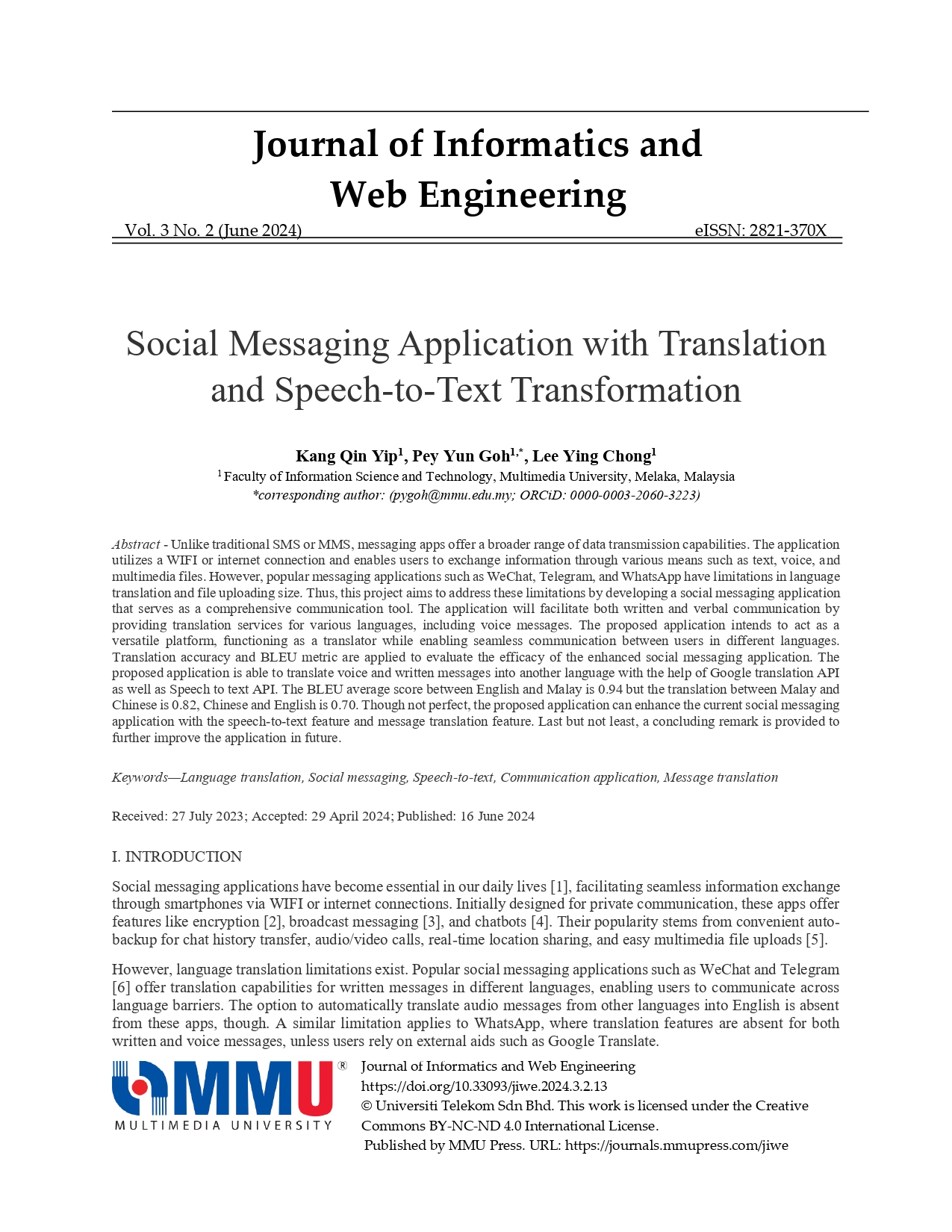Social Messaging Application with Translation and Speech-to-Text Transformation
Main Article Content
Abstract
Unlike traditional SMS or MMS, messaging apps offer a broader range of data transmission capabilities. The application utilizes a WIFI or internet connection and enables users to exchange information through various means such as text, voice, and multimedia files. However, popular messaging applications such as WeChat, Telegram, and WhatsApp have limitations in language translation and file uploading size. Thus, this project aims to address these limitations by developing a social messaging application that serves as a comprehensive communication tool. The application will facilitate both written and verbal communication by providing translation services for various languages, including voice messages. The proposed application intends to act as a versatile platform, functioning as a translator while enabling seamless communication between users in different languages. Translation accuracy and BLEU metric are applied to evaluate the efficacy of the enhanced social messaging application. The proposed application is able to translate voice and written messages into another language with the help of Google translation API as well as Speech to text API. The BLEU average score between English and Malay is 0.94 but the translation between Malay and Chinese is 0.82, Chinese and English is 0.70. Though not perfect, the proposed application can enhance the current social messaging application with the speech-to-text feature and message translation feature. Last but not least, a concluding remark is provided to further improve the application in future.
Article Details

This work is licensed under a Creative Commons Attribution-NonCommercial-NoDerivatives 4.0 International License.
All articles published in JIWE are licensed under a Creative Commons Attribution-NonCommercial-NoDerivatives 4.0 International (CC BY-NC-ND 4.0) License. Readers are allowed to
- Share — copy and redistribute the material in any medium or format under the following conditions:
- Attribution — You must give appropriate credit, provide a link to the license, and indicate if changes were made. You may do so in any reasonable manner, but not in any way that suggests the licensor endorses you or your use;
- NonCommercial — You may not use the material for commercial purposes;
- NoDerivatives — If you remix, transform, or build upon the material, you may not distribute the modified material.
References
J. Pierson, “Digital platforms as entangled infrastructures: Addressing public values and trust in messaging apps”, European Journal of Communication, vol. 36(4), pp. 349-361, 2021.
V. Cherotich, M. W. Muriithi, and C. J. Kiprop, “Secure Messaging Application”, Data Science and Artificial Intelligence, 2023.
A. Johns, A. Matamoros-Fernandez, and E. Baulch, “WhatsApp: From a One-to-one Messaging App to a Global Communication Platform”, John Wiley & Sons, 2023.
“Messaging Apps”, Library.theengineroom.org, n.d., retrieved May 23, 2023, from https://library.theengineroom.org/messaging-apps/#definition
A. Girdhar, “6 Reasons Why Messaging Apps Are Popular”, Appy Pie, 2022, retrieved May 20, 2023, from https://www.appypie.com/why-messaging-apps-are-popular.
L. Zhang, and G. Pan, G., “Research on the Secure Communication Model of Instant Messaging”, In Proceedings of the 6th International Conference on Computer Science and Application Engineering, 2022, pp. 1-6.
I. Ahmad Abuarqoub, "Language barriers to effective communication", Utopía y Praxis Latinoamericana, vol. 24, 2019.
Y. Kobayashi, “The role of gender in foreign language learning attitudes: Japanese female students' attitudes towards English learning”, Gender and education, vol. 14(2), pp. 181-197, 2002.
K. Pennesi, “Improving forecast communication: linguistic and cultural considerations”, Bulletin of the American Meteorological Society, vol. 88(7), pp. 1033-1044, 2007.
A. Kumar, “News Language and Sensational Issues in Hindi News: An Empirical Study on Hindi News Anchors”, Our Heritage, 68(30), 1-9, 2020.
B. Uslu, “The effect of foreign language acquisition on preschool children’s self-regulation and social skills”, European Early Childhood Education Research Journal, vol. 28(4), pp. 548-567, 2020.
J. Zhang, and Y. Wu, “Providing multilingual logistics communication in COVID-19 disaster relief”, Multilingua, vol. 39(5), pp. 517-528, 2020.
J. Gangneux, “Tactical agency? Young people’s (dis) engagement with WhatsApp and Facebook Messenger. Convergence”, 27(2), pp. 458-471, 2021.
“10 Years of WeChat History”, EGGist, n.d., retrieved May 23, 2023 from https://www.eggsist.com/en/insights/10-years-wechat-history/.
M. Szurawitzki, “The Chinese Messaging Application WeChat as Used by German Speakers in China. Usage Practices”, Multilingual Environments, Emojis, and Beyond. Linguistik online, vol. 113(1), pp. 111-152, 2022.
Riya, “The History of Telegram”, Feedough, 2023, retrieved May 23, 2023, from https://www.feedough.com/history-of-telegram/.
Y. C. Lim, A. S. A. Abdul Shakor, N., Mohamad, M. A. Pahrol, R. Ismail, Z. L. Chong, and R. Shaharudin, R. et al., “Head and face anthropometric study for respirators in the multi-ethnic Asian population of Malaysia”, Frontiers in Public Health, vol. 10, 972249, 2022.
B. Shmueli, “NLP Metrics Made Simple: The BLEU Score”, Towards DataScience. 2021, retrieved Jun 25, 2023, from https://towardsdatascience.com/nlp-metrics-made-simple-the-bleu-score-b06b14fbdbc1.
A. K. Talha, S. Rehan, S. Zeeshan, M. A. Muhammad, and M. S. Mazliham, “Sentiment Analysis using Support Vector Machine and Random Forest”, Journal of Informatics and Web Engineering, vol. 3, pp. 67 - 75, 2024
S. Muhammad, N. Hu, T. V. Y. Timothy, and G. Vik Tor, “Performance of Sentiment Classifiers on Tweets of Different Clothing Brands”, Journal of Informatics and Web Engineering, vol. 1, pp. 16 - 22, 2022.

